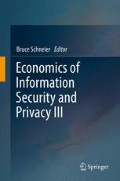Abstract
Much of the information we have on cyber-crime losses is derived from surveys. We examine some of the difficulties of forming an accurate estimate by survey. First, losses are extremely concentrated, so that representative sampling of the population does not give representative sampling of the losses. Second, losses are based on unverified self-reported numbers. Not only is it possible for a single outlier to distort the result, we find evidence that most surveys are dominated by a minority of responses in the upper tail (i.e., a majority of the estimate is coming from as few as one or two responses). Finally, the fact that losses are confined to a small segment of the population magnifies the difficulties of refusal rate and small sample sizes. Far from being broadly-based estimates of losses across the population, the cyber-crime estimates that we have appear to be largely the answers of a handful of people extrapolated to the whole population. A single individual who claims $50,000 losses, in an N = 1, 000 person survey, is all it takes to generate a $10 billion loss over the population. One unverified claim of $7,500 in phishing losses translates into $1.5 billion.
Access this chapter
Tax calculation will be finalised at checkout
Purchases are for personal use only
References
Anderson R, Boehme R, Clayton R, Moore T (2007) Security economics and the internal market. Report for European network and information security agency, 2007
Andreas P, Greenhill K (2010) Sex, drugs, and body counts: the politics of numbers in global crime and conflict. Cornell University Press, New York
Assael H, Keon J (1982) Nonsampling vs. sampling errors in survey research
Avery R, Elliehausen G, Kennickell A (1988) Measuring wealth with survey data: an evaluation of the 1983 survey of consumer finances. Rev Income Wealth 34(4):339–369
Bureau of Justice Statistics. Victims of Identity Theft. http://bjs.ojp.usdoj.gov/content/pub/pdf/vit08.pdf
Federal Trade Commission (2003) Identity theft survey report. http://www.ftc.gov/os/2003/09/synovatereport.pdf
Federal Trade Commission (2007) Identity theft survey report. www.ftc.gov/os/2007/11/SynovateFinalReportIDTheft2006.pdf
Federal Reserve Board. Survey of Consumer Finances. http://www.federalreserve.gov/pubs/oss/oss2/scfindex.html
Florêncio D, Herley C (2010) Where do security policies come from? In: SOUPS 2010, Redmond
Gartner (2007) Phishing survey. http://www.gartner.com/it/page.jsp?id=565125
Herley C, Florêncio D (2008) A profitless endeavor: phishing as tragedy of the commons. In: NSPW 2008, Lake Tahoe, CA
Herley C, Florêncio D (2009) Nobody sells gold for the price of silver: dishonesty, uncertainty and the underground economy. In: WEIS 2009, London
Howard M, LeBlanc D, and Books I (2003) 24x7. Writing secure code, vol 2. Microsoft press, Washington
Internet Crime Complaint Center Annual Crime Report. http://www.ic3.gov/media/annualreports.aspx
Javelin (2003) Identity theft survey report. http://www.javelinstrategy.com/uploads/505.RF_Phishing.pdf
Javelin (2009) Identity theft survey report. http://www.javelinstrategy.com/uploads/505.RF_Phishing.pdf
Kennickell A (1998) Multiple imputation in the Survey of Consumer Finances. In: Proceedings of the section on business and economic statistics, 1998 annual meetings of the American statistical association, Dallas, Texas. Citeseer, 1998
Kennickell A (2009) Getting to the top: reaching wealthy respondents in the SCF. Washington, DC: Federal reserve board of governors, 2009
Lichtman S, Pisarska K, Berman E, Pestone M, Dowling H, Offenbacher E, Weisel H, Heshka S, Matthews D, Heymsfield S (1992) Discrepancy between self-reported and actual caloric intake and exercise in obese subjects. New Engl J Med 327(27):1893–1898
Lorenz J, Rauhut H, Schweitzer F, Helbing D (2011) How social influence can undermine the wisdom of crowd effect. Proc Natl Acad Sci 108(22):9020
Measuring the Effectiveness of In-the-Wild Phishing Attacks. (2009) http://www.trusteer.com/sites/default/files/Phishing-Statistics-Dec-2009-FIN.pdf
Moitra SD. Cyber security violations against businesses: a re-assessment of survey data. http://www.iimcal.ac.in/res/upd\%5CWPS\%20571.pdf
Moore T, Clayton R (2007) Examining the impact of website take-down on phishing. In: Proceedings of APWG eCrime summit, 2007
Morris M (1993) Telling tails explain the discrepancy in sexual partner reports. Nature
National Strategy for Trusted Identities in Cyberspace. Why we need it. http://www.nist.gov/nstic/NSTIC-Why-We-Need-It.pdf
New Scientist (2008) Cybercrime toll threatens new financial crisis. Nov. 20, 2008. http://www.newscientist.com/article/dn16092-cybercrime-toll-threatens-new-financial-crisis.html
Newman M (2005) Power laws, Pareto distributions and Zipf’s law. Contemp Phys 46(5):323–351
Paterson P (2010) The Morphing IT Security Landscape. Nov. 18, 2010 https://vishnu.fhcrc.org/security-seminar/IT-Security-Landscape-Morphs.pdf
Ryan J, Jefferson TI (2003) The use, misuse, and abuse of statistics in information security research. In: Proceedings 23rd ASEM national conference, 2003
Shostack A, Stewart A (2008) The new school of information security research
Systems Solutions Group: Cyber Crime http://www.ssg-inc.net/cyber_crime/cyber_crime.html
TaoSecurity Blog: Brief Thoughts on WEIS (2010) http://taosecurity.blogspot.com/2010/07/brief-thoughts-on-weis-2010.html. July 14, 2010
Tukey J (1960) A survey of sampling from contaminated distributions. I. Olkin, 1960
Wiederman M (1997) The truth must be in here somewhere: examining the gender discrepancy in self-reported lifetime number of sex partners. J Sex Res 34(4):375–386
Author information
Authors and Affiliations
Corresponding author
Editor information
Editors and Affiliations
Rights and permissions
Copyright information
© 2013 Springer Science+Business Media New York
About this paper
Cite this paper
Florêncio, D., Herley, C. (2013). Sex, Lies and Cyber-Crime Surveys. In: Schneier, B. (eds) Economics of Information Security and Privacy III. Springer, New York, NY. https://doi.org/10.1007/978-1-4614-1981-5_3
Download citation
DOI: https://doi.org/10.1007/978-1-4614-1981-5_3
Published:
Publisher Name: Springer, New York, NY
Print ISBN: 978-1-4614-1980-8
Online ISBN: 978-1-4614-1981-5
eBook Packages: Computer ScienceComputer Science (R0)

